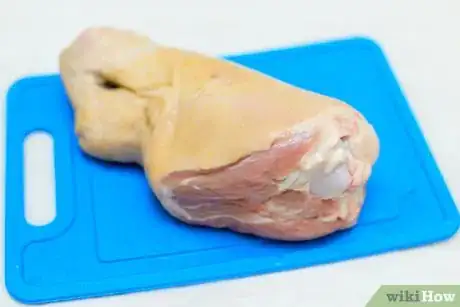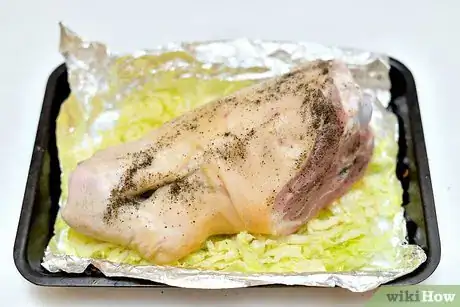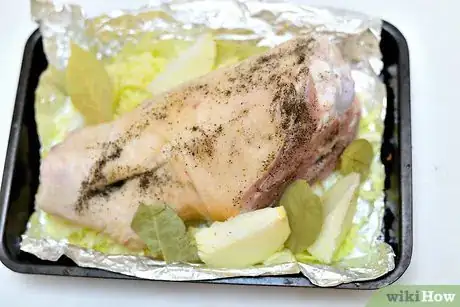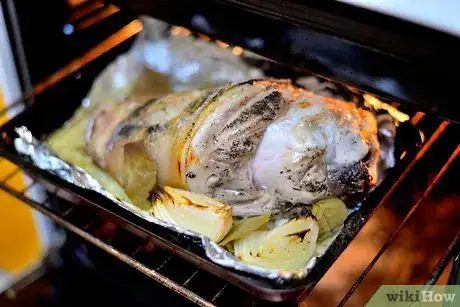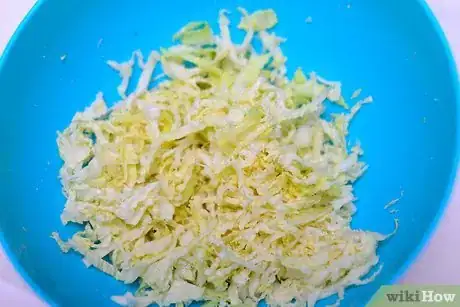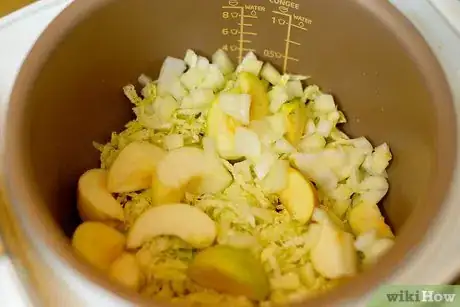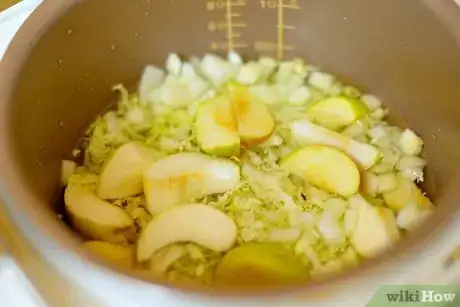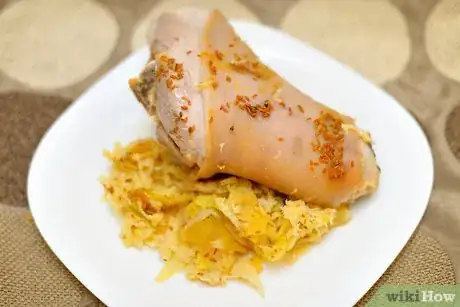This article was co-authored by wikiHow staff writer, Jessica Gibson. Jessica Gibson is a Writer and Editor who's been with wikiHow since 2014. After completing a year of art studies at the Emily Carr University in Vancouver, she graduated from Columbia College with a BA in History. Jessica also completed an MA in History from The University of Oregon in 2013.
This article has been viewed 26,410 times.
Learn more...
Eisbein is a classic German recipe that turns a tough cut of pork, the knuckles or hocks, into a tender, flavorful meal. Use fresh or cured pork knuckles or hocks and season them with traditional pickling spices. Arrange the pork over sauerkraut and roast them in a low oven until the meat is tender. You can even make eisbein with a slightly sweet sauerkraut in the slow cooker.
Ingredients
- 3 1/3 pounds (1.5 kg) fresh pork knuckles
- 2 1/8 cups (520 g) sauerkraut
- 3 tablespoons (45 ml) water
- 3 small onions
- 7 juniper berries
- 1 teaspoon (2 g) coriander
- 1 teaspoon (2 g) cumin
- 1 teaspoon (2 g) caraway
- 2 bay leaves
- Salt and pepper to taste
Makes 3 to 4 servings
- 3 cups (708 g) sauerkraut
- 4 cups (0.9 liter) beef stock
- 2 apples
- 1 medium white onion or 2 tablespoons (10 g) dried onion
- 2 cured or fresh pork knuckles or 4 ham hocks
- 2 teaspoons (4 g) caraway seed
- 2 teaspoons (3 g) juniper berries
- 3 bay leaves
- 1 cup (240 ml) amber or dark beer (optional)
Makes 4 servings
Steps
Making Traditional Eisbein with Sauerkraut
-
1Preheat the oven and wash the pork knuckles. Turn the oven on to 400 °F (204 °C). Get out 3 1/3 pounds (1.5 kg) fresh pork knuckle and rinse them off. Use paper towels to pat them dry.[1]
- Rinsing the pork knuckles will remove some of the excess saltiness from the dish.
-
2Season the pork knuckles and cut the onions. Sprinkle the pork knuckles with salt and pepper and set them aside. Peel 3 small onions and slice them in half.[2]
- You can use your favorite type of onion.
Advertisement -
3Arrange the sauerkraut and pork knuckles in a dish. Pour 3 tablespoons (45 ml) of water into a shallow oven-safe dish (such as a 9 x 13 x 2 or 22 x 33 x 5 cm dish). Spread 2 1/8 cups (520 g) of sauerkraut evenly across the bottom of the dish. Place the pork knuckles on the sauerkraut.[3]
- Since the pork knuckles will release some fat, greasing the pan is optional. To make clean up easier, you could spray the pan with cooking spray before placing the ingredients in the dish.
-
4Add the onion and seasonings to the dish. Place the onion halves and 2 bay leaves in the dish. Sprinkle the pork knuckles and sauerkraut with:[4]
- 7 juniper berries
- 1 teaspoon (2 g) coriander
- 1 teaspoon (2 g) cumin
- 1 teaspoon (2 g) caraway
- Salt and pepper to taste
-
5Bake the eisbein for 2 hours. Cover the dish with a lid and put it in the preheated oven. Bake the pork knuckles until the meat becomes completely tender. This should take about 2 hours.[5]
- If the dish doesn't have a lid, cover the dish tightly with aluminum foil.
-
6Broil the eisbein if you want a crispy skin. If you'd like crispy South African-style eisbein, remove the cooked eisbein from the oven. Turn on your broiler to high and move the oven rack so it's 3 to 4 inches (7 to 10-cm) below the heat source. Put the eisbein on a baking sheet and set the rack under the broiler. Broil and turn the meat occasionally until the skin crisps up and becomes crackly. This should take 20 minutes.
-
7Serve the eisbein. Remove the dish from the oven and transfer the eisbein to a serving plate. Scoop the hot sauerkraut on the side and serve the meal with boiled potatoes, mashed potatoes, or mashed peas.[6]
- You can store the eisbein in an airtight container in the refrigerator for 3 to 4 days. Simply reheat the meat in the oven at a low temperature [no more than 350 °F (177 °C)] until it's hot throughout.
Making Eisbein in the Slow Cooker
-
1Rinse the sauerkraut. Set a fine mesh strainer over your sink. Measure 3 cups (708 g) of sauerkraut into the strainer and run cold water over it. Rinse the sauerkraut and let the excess water drain off. Transfer the drained sauerkraut to a slow cooker that's at least 4-quarts (3.78 liters) in size. To make clean up easier, you can spray the inside of the slow cooker with cooking spray or insert a disposable liner.[7]
- Rinsing the sauerkraut will prevent the flavor from becoming overpowering as the eisbein cooks.
-
2Cut the apples and the onion. Peel 2 apples and 1 medium white onion. Use a sharp knife to dice the onion into small 1/2 inch (12 mm) pieces. Chop 1 of the apples into 1-inch (2.5 cm) pieces. Grate the other apple against the coarse side of a vegetable grater. Put the onion and apples into the slow cooker.[8]
- You can use your favorite type of apple. Keep in mind that tart apples (such as Granny Smiths or Pink Ladies) work well with the flavors of the eisbein.
- If you don't want to use fresh onion, you can substitute 2 tablespoons (10 g) of dried onion.
-
3Pour in beef stock and beer. Measure 4 cups (0.9 liter) of beef stock and pour it into the slow cooker. For a rich, hoppy flavor, you can also add 1 cup (240 ml) of amber or dark beer. Stir the mixture in the slow cooker to combine the ingredients.[9]
-
4Add the pork and seasonings. Put 2 cured or fresh pork knuckles or 4 ham hocks into the slow cooker. Place 3 bay leaves in the slow cooker and sprinkle 2 teaspoons (4 g) caraway seed and 2 teaspoons (3 g) of juniper berries over the pork.[10]
-
5Cook the eisbein for 8 hours. Put the lid on the slow cooker and turn it on to LOW. Slow cook the pork until it's completely tender. This should take about 8 hours. Serve the eisbein with the sauerkraut, potato dumplings, and mustard.[11]
- You can store the eisbein in an airtight container in the refrigerator for 3 to 4 days. Simply reheat the meat in the oven at a low temperature [no more than 350 °F (177 °C)] until it's hot throughout.
Things You'll Need
Traditional Eisbein with Sauerkraut
- Paper towels
- Measuring cups and spoons
- Digital scale
- Baking sheet
- Shallow oven-safe dish (such as a 9 x 13 x 2 or 22 x 33 x 5 cm dish) with lid
- Cooking spray, optional
- Aluminum foil, optional
Slow Cooker Eisbein
- Measuring cups and spoons
- Digital scale
- Slow cooker (at least 4-quarts or 3.78 liters) in size
- Spoon
- Fine mesh strainer
- Vegetable grater
- Knife and cutting board
References
- ↑ https://germanfoods.org/recipe/eisbein-mit-sauerkraut-pork-knuckle-sauerkraut/
- ↑ https://germanfoods.org/recipe/eisbein-mit-sauerkraut-pork-knuckle-sauerkraut/
- ↑ https://germanfoods.org/recipe/eisbein-mit-sauerkraut-pork-knuckle-sauerkraut/
- ↑ https://germanfoods.org/recipe/eisbein-mit-sauerkraut-pork-knuckle-sauerkraut/
- ↑ https://germanfoods.org/recipe/eisbein-mit-sauerkraut-pork-knuckle-sauerkraut/
- ↑ https://germanfoods.org/recipe/eisbein-mit-sauerkraut-pork-knuckle-sauerkraut/
- ↑ https://www.kitchenproject.com/german/recipes/Sauerkraut/Crockpot-Sauerkraut/index.htm
- ↑ https://www.kitchenproject.com/german/recipes/Sauerkraut/Crockpot-Sauerkraut/index.htm
- ↑ https://www.kitchenproject.com/german/recipes/Sauerkraut/Crockpot-Sauerkraut/index.htm
